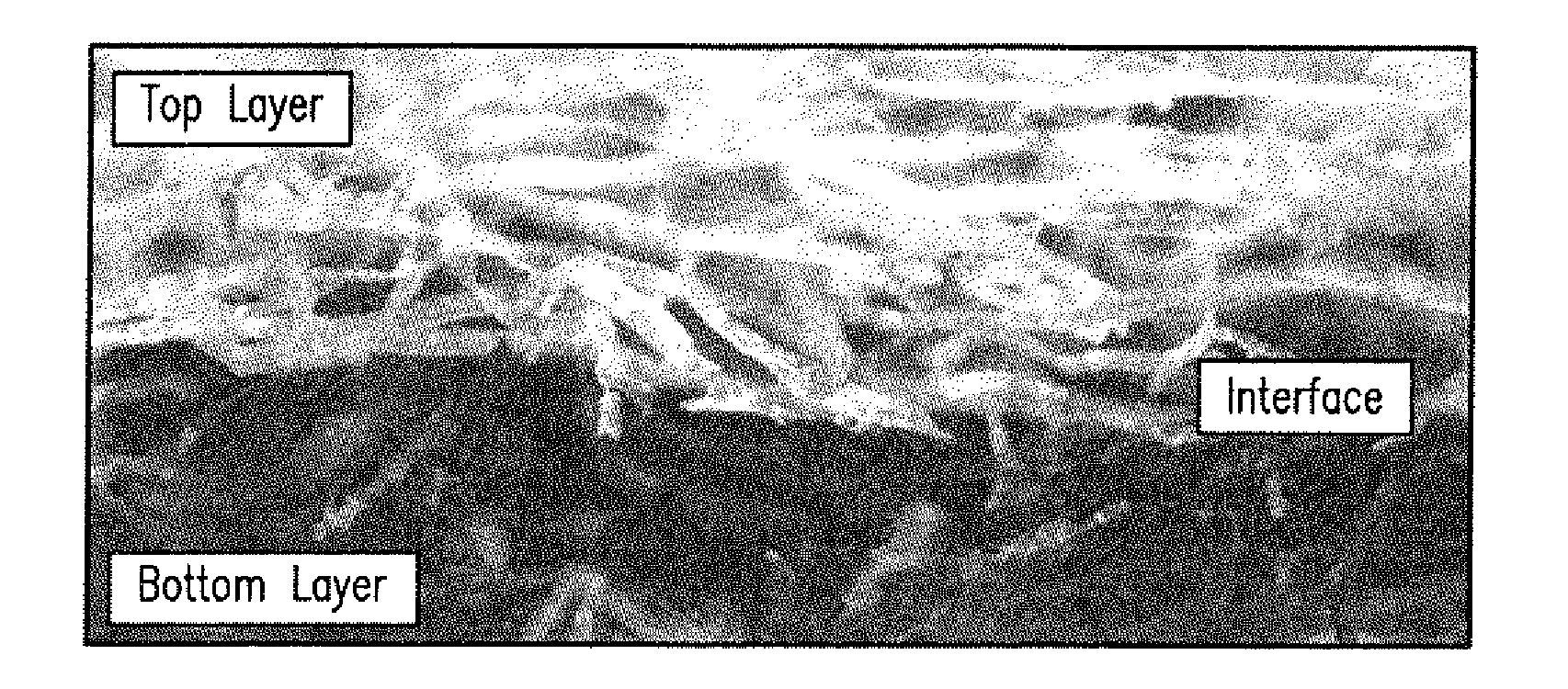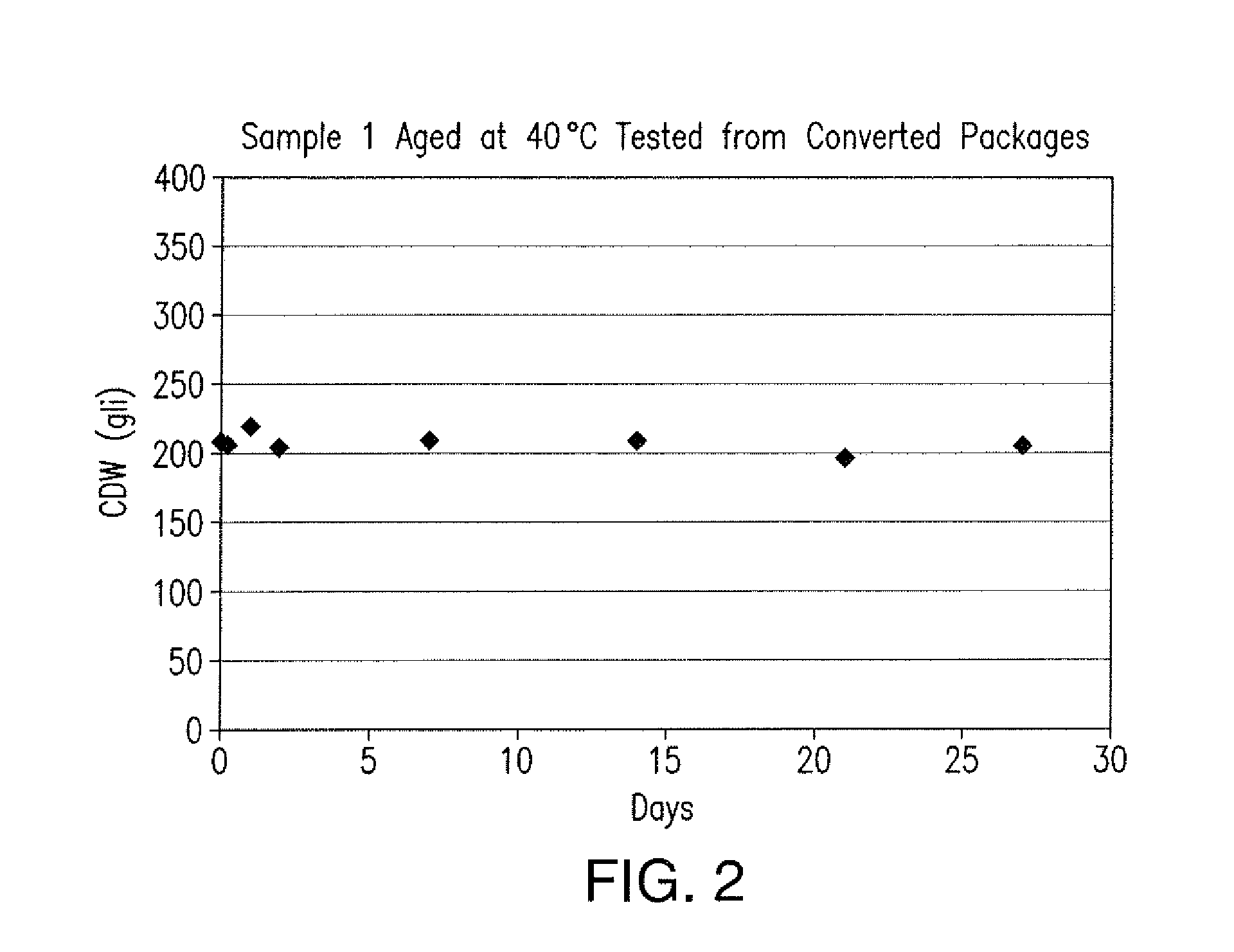Dispersible nonwoven wipe material
a non-woven, wipe technology, applied in the direction of window cleaners, carpet cleaners, cleaning equipments, etc., can solve the problems of affecting the dispersibility of non-dispersible wipes, causing the burden of non-dispersible wipes to pass, and causing problems such as difficulty in dispersing, etc., to achieve sufficient dry and wet strength and easy dispersal
- Summary
- Abstract
- Description
- Claims
- Application Information
AI Technical Summary
Benefits of technology
Problems solved by technology
Method used
Image
Examples
example 1
Dispersible Wipes
[0157]Wipes according to the invention were prepared and tested for various parameters including basis weight, CDW, MDD, and caliper.
[0158]METHODS / MATERIALS: Samples 1, 1B, 1C, 2, 3, 4, 5, 6 and 7 were made on a commercial airlaid drum forming line with through air drying. The compositions of these samples are given in Tables 1-9. The level of raw materials was varied to influence the physical properties and flushable—dispersible properties. Product lot analysis was carried out on each roll.
TABLE 1Sample 1Basis WeightLayerRaw Materials(gsm)Weight %TopWacker Vinnapas EP9072.84.03Trevira Merge 1661 T2551.11.6bicomponent fiber, 2.2 dtex × 12 mmBuckeye Technologies FFT-AS pulp8.912.82Trevira Merge 1661 T2550.00.0bicomponent fiber, 2.2 dtex × 12 mmBuckeye Technologies FFT-AS pulp15.422.01Trevira Merge 1661 T2556.18.7bicomponent fiber, 2.2 dtex × 12 mmBuckeye Technologies FFT-AS pulp32.947.0BottomWacker Vinnapas EP9072.84.0Total70.0
TABLE 2Sample 1BBasis WeightLayerRaw Mat...
example 2
Sample 1 Aging Study
[0161]An aging study was conducted to determine if the Sample 1 wipe would be adversely impacted over time after converting. The study was accelerated by placing the wipes, sealed in their original packaging, at a temperature of 40° C. The study was conducted over a 27 day period after which point it was stopped based on the results of the testing given in Table 2 and FIG. 2.
[0162]METHODS / MATERIALS: Sample 1 was converted by wetting the wipe with lotion, cutting it, and packaging it in a sealed container. Converted packages were placed in an oven at 40° C. for the period of time shown in Table 2. The time of “0” days indicates that the material was taken straight from the package and tested before being placed in the oven. At least ten wipes were tested for each data point using an average of 5 packages of previously unopened wipes. Using an unopened package of wipes is critical to ensure that no contamination or loss of moisture occurs with the wipes. All of the...
example 3
Aerobic Biodegradability and Biodisintegration
[0164]Sample 1 was tested for biodisintegration and aerobic biodegradability according to the industry accepted standards as set forth in the Guidance Document for Assessing Flushability of Nonwoven Consumer Products, Second Edition, July 2009 and published by the Association of the Nonwoven Fabrics Industry (“INDA Guidelines”). These tests are the INDA Guidelines FG 513.2 test and the Organisation for Economic Co-operation and Development (“OECD”) 301B test and the International Organization for Standardization's ISO 14852 method.
[0165]METHODS / MATERIALS: Aerobic biodegradation was determined by CO2 production. Prior to testing, a mineral medium was prepared and inoculated with activated sludge from the Ann Arbor Waste Water Treatment Plant. Activated sludge was adjusted from a measured total suspended solids value of 2000 mg / L to 3000 mg / L by decanting an appropriate amount of supernatant. The samples used were Sample 1. The materials u...
PUM
| Property | Measurement | Unit |
|---|---|---|
| weight percent | aaaaa | aaaaa |
| weight percent | aaaaa | aaaaa |
| weight percent | aaaaa | aaaaa |
Abstract
Description
Claims
Application Information
 Login to View More
Login to View More - R&D
- Intellectual Property
- Life Sciences
- Materials
- Tech Scout
- Unparalleled Data Quality
- Higher Quality Content
- 60% Fewer Hallucinations
Browse by: Latest US Patents, China's latest patents, Technical Efficacy Thesaurus, Application Domain, Technology Topic, Popular Technical Reports.
© 2025 PatSnap. All rights reserved.Legal|Privacy policy|Modern Slavery Act Transparency Statement|Sitemap|About US| Contact US: help@patsnap.com



